tire size AUDI S4 2016 Owners Manual
[x] Cancel search | Manufacturer: AUDI, Model Year: 2016, Model line: S4, Model: AUDI S4 2016Pages: 278, PDF Size: 70.26 MB
Page 180 of 278
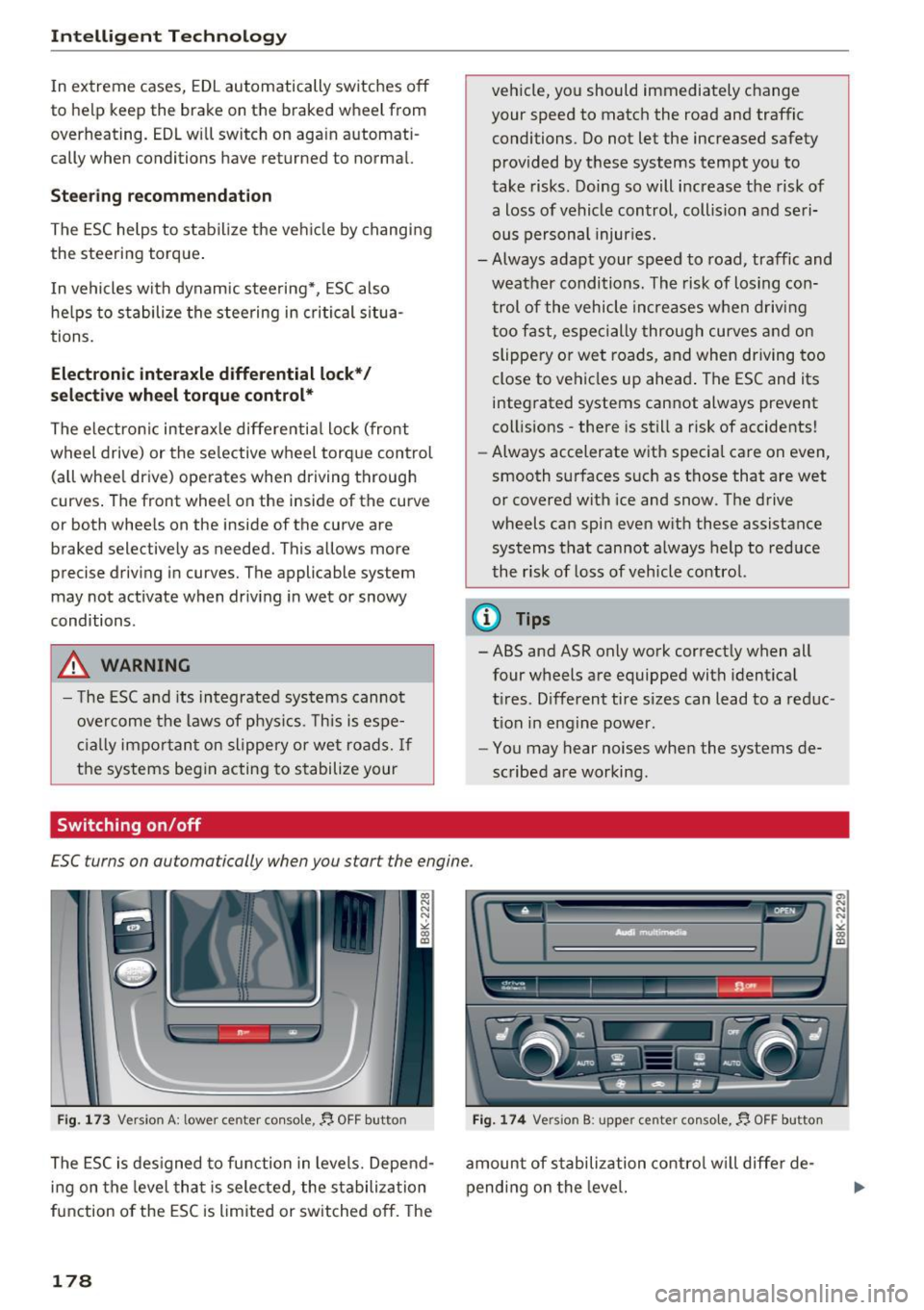
Inte llig ent Techn olo gy
In extreme cases, EDL automatically switches off
to help keep the brake on the braked wheel from
overheating. EDL will switch on aga in automati
cally when conditions have returned to normal.
St eer ing r ecomm endation
The ESC helps to stabilize the vehicle by chang ing
the steering torque .
I n vehicles with dynamic steering*, ESC also
helps to stabilize the stee ring in critical situa
tions.
Electron ic inter axle differential lock*/
sel ective whe el t orque control *
The electronic interaxle differentia l lock (front
wheel drive) or the selective wheel torque control
(a ll whee l drive) operates when driving through
curves . The front wheel on the inside of the curve
or both wheels on the inside of the curve are
braked selectively as needed. This allows more
precise driving in curves. The applicable system
may not activate when driving in wet or snowy
conditions.
.,&. WARNING
- The ESC and its in tegrated systems canno t
overcome the laws of phys ics. This is espe
c ially important on slippery or wet roads.
If
the systems begin acting to stabilize your
Switching on /off
vehicle, you should immediately change
your speed to match the road and traffic
conditions. Do not let the increased safety
provided by these systems tempt you to
take risks. Doing so will increase the risk of
a loss of vehicle control, collision and seri
ous personal injuries.
- Always adapt your speed to road, traffic and
weather conditions. The risk of los ing con
trol of the vehicle increases when driving
too fast, espec ially through curves and on
slippery o r wet roads, and when driving too
close to vehicles up ahead . The ESC and its
integrated systems cannot always prevent
collisions -there is still a risk of accidents!
- Always accelerate with specia l care on even,
smooth surfaces such as those that are wet
or covered with ice and snow. The drive
wheels can spin even with these assistance
systems that cannot always help to reduce
the risk of loss of vehicle control.
@ Tips
- ABS and ASR only work correct ly when all
four wheels are equipped with identical
t ires. Different tire sizes can lead to a reduc
t ion in engine power.
- You may hear noises when the systems de
scribed are working.
ESC turns on automatically when you start the engine .
Fig. 173 Version A: lower center console,~ OFF button
The ESC is des igned to function in levels. Depend
i n g on the level tha t is selected, the stabilization
function of the ESC is limited or switched off. The
178
Fig. 174 Version B: upper center console,~ OFF button
amount of stabilization contro l w ill diffe r de
pending on the level.
"' N N N ~ 0:, m
Page 184 of 278

Intelligent Technology
(D Tips
- If the . or
,~ n ind icator light only stays on
fo r a short time, you may continue driving.
- The dynamic steering* stability systems are
not available in the event of a system mal
funct ion.
- Fo r additional information on dynamic
steering*, refer to¢
page 111 .
Driving with your
quattro
Applies to veh icles: w ith all-wheel drive
With all-wheel drive, all four wheels are driven.
General information
With all-whee l drive, power is distributed to all
four wheels . This happens automatically depend
ing on your dr iv ing style and the road condit ions
at the time . See also ¢
page 177 .
A center differentia l distrib utes the driv ing power
variably to the front and rear axle. It works to gether with selective wheel torque control, which
activates when driving through curves
¢
page 178 . With the sport differentia l*, power
d istr ibut io n to the rear wheels is variable and can
be adj usted w ith d rive select¢
page 111.
The all -wheel drive concept is designed for high
engine power . Your veh icle is exceptionally pow
erful and has excellent driving characterist ics
both under normal dr iv ing condit io ns and on
snow and ice. Always read and fo llow safety pre
cautions ¢
A.
Winter tires
When d rivi ng in the winter, your vehicle with all
wheel drive has an advantage, eve n with regular
tires. In winter road conditions it may be adv isa
b le to mount w inte r ti res (or all-season tires) fo r
improved driveability and braking: these tires
must be mounted on all four wheels . See a lso
¢ page 232, Winter tires.
Tire chains
Where ti re chains are mandatory on certain
roads, this norma lly also applies to vehicles w ith
all -whee l drive ¢
page 233, Snow chains .
182
Replacing wheels /tires
Vehicles with all-wheel d rive must a lways have
tires of the same size. Also avoid t ires with differ
ent tread depths. For detai ls see page
¢ page 224, New tires or wheels .
Off-Road driving?
You r A udi does not have eno ugh ground clear
an ce to be used as an off-road vehicle.
It is there
fore best to avoid ro ugh tracks and uneven ter
rain as much as possib le. Also refer to
¢ page 185.
A WARNING
A lways adjust your dr iving to road and traffic
conditions . Do not let the extra safety afford
ed by all-whee l drive tempt you into taking
extra risks .
- Although the all-wheel drive is very effec
tive, always remember that braking capacity
is limited by ti re tract ion. You s hou ld there
fore not drive at excessive speeds on icy or
slippe ry road s urfaces.
- On wet road surfaces, be careful not to dr ive
too fast because the front wheels could be
gi n to slide on top of the water (aquaplan
ing) . If th is should occur, you will have no
warning from a s udden increase in engine
speed as with a front-wheel drive vehicle.
Always drive at speeds which are suited to
the road conditions -risk of crash .
Energy management
Starting ability is optimized
Energy management controls the distribution of
electrical energy and thus optimizes the availa
bility of electrical energy for starting the engine .
If a vehicle with a conventional energy system is
not driven for a long period of time, the batte ry is
discharged by id ling current consumers (e.g . im
mobilizer). In ce rtain circumstances it can resu lt
i n the re being insufficient energy avai lab le to
start the engine .
Intelligent energy management in yo ur vehicle
hand les t he d istribution of elect rical energy. .,.
Page 190 of 278
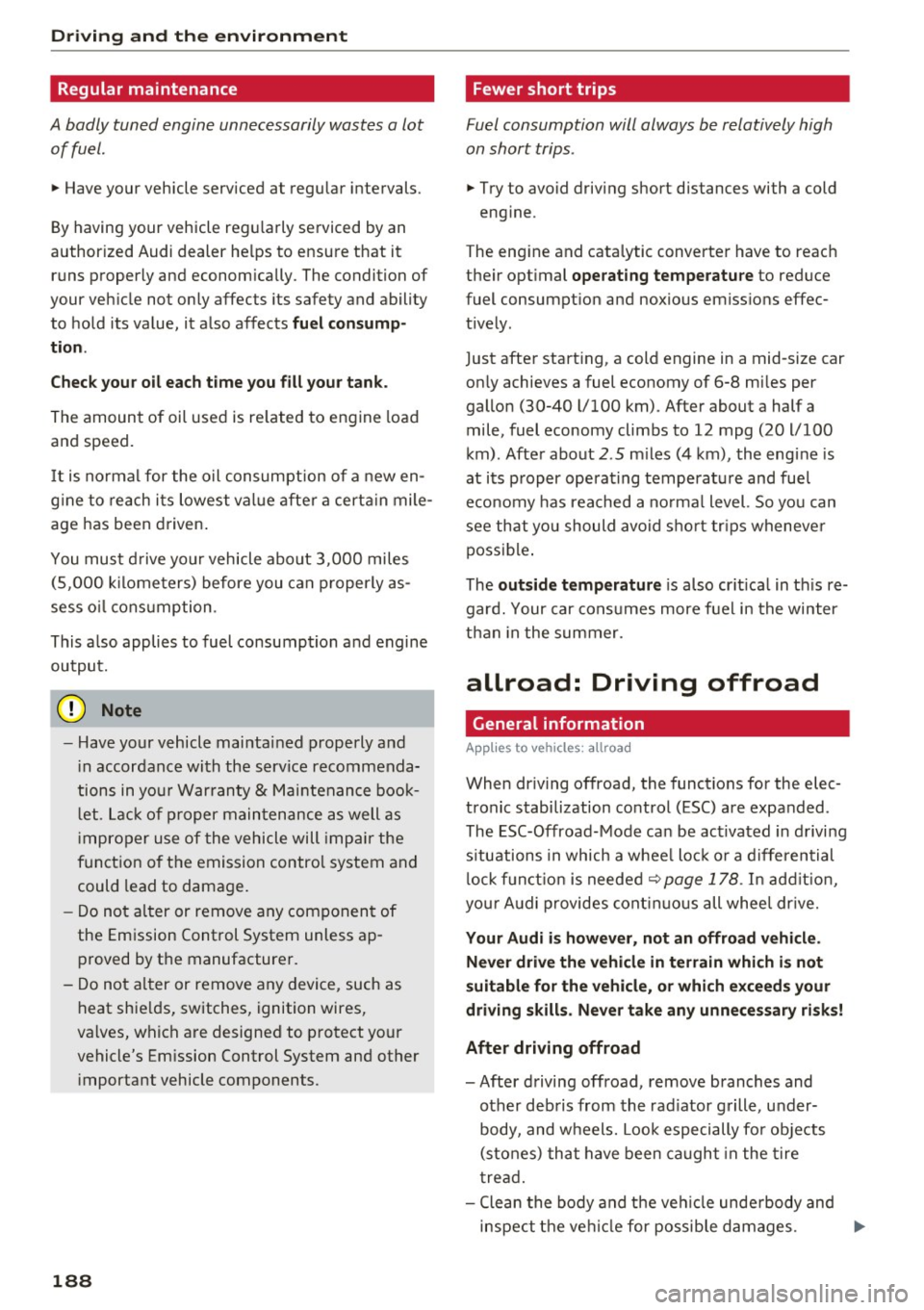
Driving and th e en vironm ent
Regular maintenance
A badly tuned engine unnecessarily wastes a lot of fuel.
.,. Have your vehicle serviced at regular intervals.
By having your vehicle regu larly serviced by an
author ized Audi dealer he lps to ensure that it
runs properly and econom ically . The condition of
your veh icle not only affects its safety and ability
to hold its value, it also affects
fu el consump
tion .
C he ck your oil e ach t ime you fill you r ta nk .
The amount of oil used is re lated to engine load
and speed.
It is normal for the oil consumpt ion of a new en
g ine to reach its lowest val ue afte r a certa in mile
age has been driven .
You must d rive you r vehicle about 3 ,000 miles
(5,000 k ilome ters) before you can p roperly as
sess o il cons umption .
This a lso applies to fuel consumption and engine
outpu t.
(D Note
- Have your vehicle maintained properly and
in accordance with the service recommenda
tions in you r Warranty
& Maintenance book
l et . La ck of p roper main tenance as well as
i mproper use of the vehicle will impa ir the
f u nct ion of the emission control system and
could lead to damage.
- Do not al ter or remove any component of
the Emission Control System unless ap proved by the manufacturer.
- Do not a lter or remove any device, such as
heat shie lds, switches, ignition wires,
valves, which are designed to protect your
vehicle's Emission Control System and other i mportant vehicle components.
188
· Fewer short trips
Fuel consumption will always be relatively high
on short trips .
.,. Try to avoid driving short distances with a cold
eng ine .
T he eng ine and catalytic converter have to reac h
their opt imal
operating temper atu re to reduce
fuel consumpt ion and noxious emiss ions effec
tively .
Just after start ing, a cold engine in a mid-size car
on ly achieves a fuel economy of 6-8 miles per
gallon (30-40 l/100 km) . After about a half a
mile, fuel economy climbs to 12 mpg (20 l/100
km) . After about
2 .5 m iles (4 km), the engine is
at its proper operating temperatu re and fuel
economy has reached a no rma l level. So you can
see that you should avoid sho rt tr ips wheneve r
possible .
The
out sid e temperatur e is also cr it ica l in th is re
gard. Your car cons umes more fue l in the winter
than in the summer.
allroad: Driving offroad
General information .
App lies to vehicles : allroad
When dr iving offroad, the functions for the elec
tronic stabilization co ntrol (ESC) are expanded .
The ESC-Offroad-Mode ca n be activated in d riving
s ituations in which a wheel loc k or a d iffe rential
l ock f unct ion is needed ~
page 178. In addit ion,
you r A udi p rovides cont in uo us all whee l dr ive.
You r Audi i s how ever, not an offroad vehicl e.
Nev er dri ve the vehicl e in t errain whi ch i s not
suitable for the vehicl e, or whi ch exce ed s your
driving skills . Nev er take any unnece ssary ri sk s!
Afte r driving offro ad
- After driving offroad, remove branches and
other deb ris from the rad iator g rille , under
body, and wheels. Look especially fo r objects
(s tones) that have been caught in the tire
t read.
- Clean the body and the ve hicle unde rbody and
inspect the ve hicl e for possible damages.
IJI>
Page 220 of 278
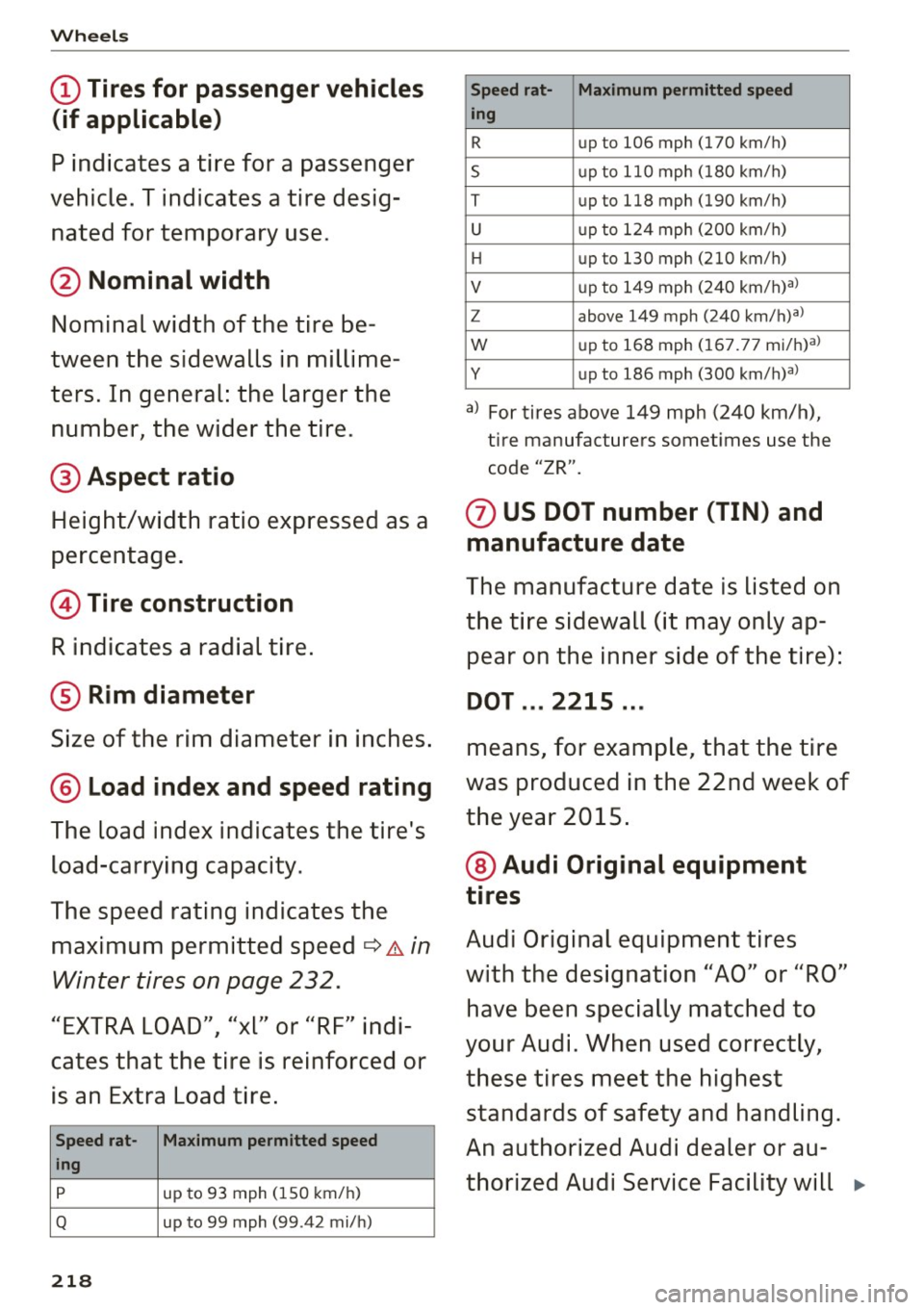
Wheels
(D Tires for passenger vehicles
(if applicable)
P indicates a tire for a passenger
vehicle. T indicates a tire desig
nated for temporary use.
@ Nominal width
Nominal width of the tire be
tween the sidewalls in millime
ters. In general: the larger the
number, the wider the tire.
@ Aspect ratio
Height/width ratio expressed as a
percentage.
@ Tire construction
R indicates a radial tire.
® Rim diameter
Size of the rim diameter in inches.
@ Load index and speed rating
The load index indicates the tire's
load-carrying capacity.
The speed rating indicates the maximum permitted speed
¢ & in
Winter tires on page 232.
"EXTRA LOAD", "xl" or "RF" indi
cates that the tire is reinforced or
is an Extra Load tire.
Speed rat- Maximum permitted speed
ing
p
up to 93 mph (150 km/h)
Q up to 99 mph (99 .42 mi/h )
218
Speed rat- Maximum permitted speed
Ing
R
up t o 106 mph (170 km/h)
s up to 110 mph (180 km/h)
T up to 1 18 mph (190 km/h)
u up to 124 mph (200 km/h)
H up to 130 mph (210 km/h)
V up to 149 mph (240 km/h)al
z above 149 mph (240 km/h)al
w up to 168 mph (167 .77 mi/h) al
y up to 186 mph (300 km/h)al
a) For tires above 149 mph (240 km/h),
tire manufacturers sometimes use the
code "ZR".
(j) US DOT number (TIN) and
manufacture date
The manufacture date is listed on
the tire sidewall (it may only ap
pear on the inner side of the tire):
DOT ... 2215 ...
means, for example, that the tire
was produced in the 22nd week of
the year 2015.
@ Audi Original equipment
tires
Audi Original equipment tires
with the designation "AO" or "RO"
have been specially matched to
your Audi. When used correctly,
these tires meet the highest standards of safety and handling.
An authorized Audi dealer or au
thorized Audi Service Facility will .,..
Page 222 of 278
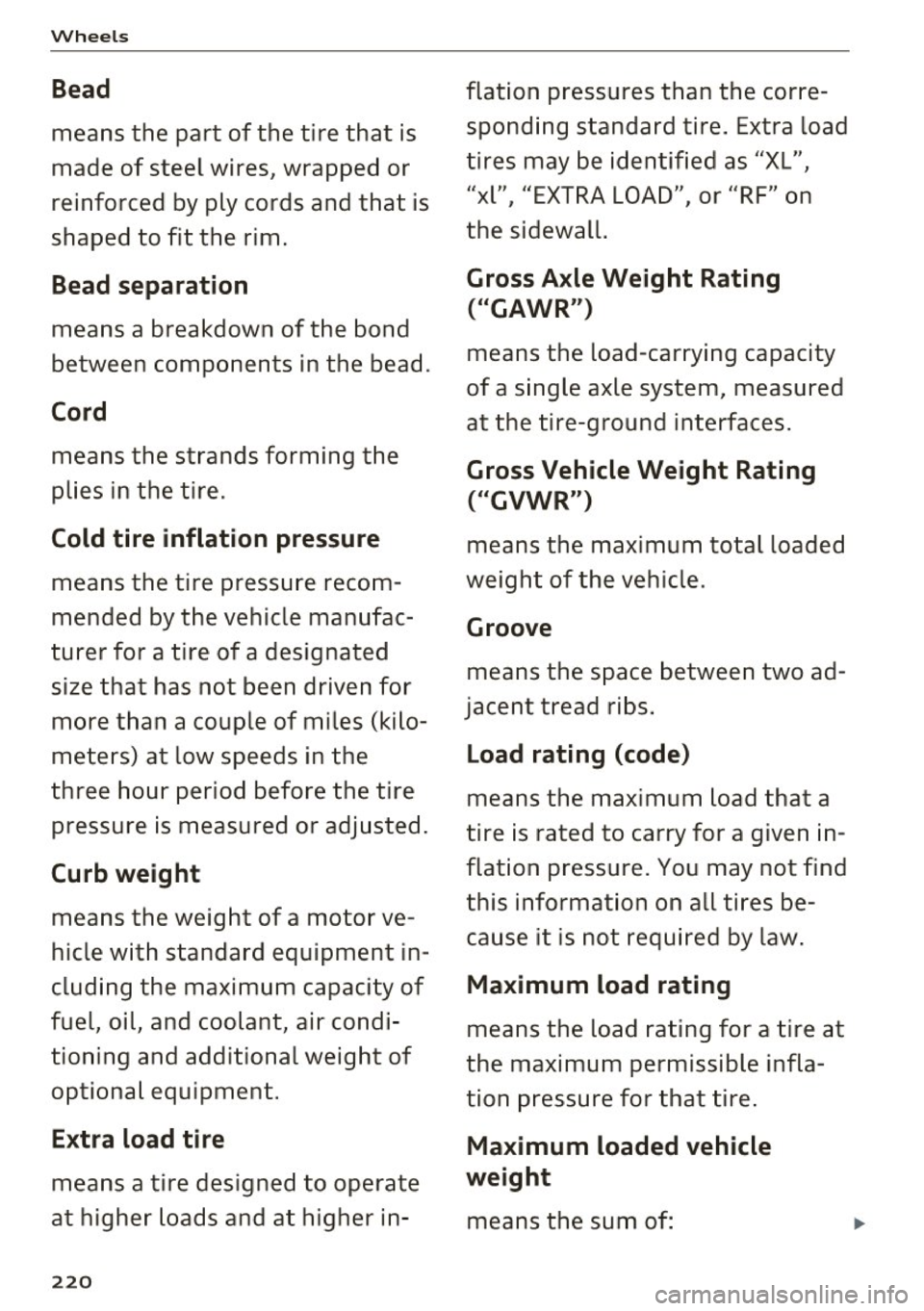
Wheels
Bead
means the part of the tire that is
made of steel wires, wrapped or
reinforced by ply cords and that is
shaped to fit the rim .
Bead separation
means a breakdown of the bond
between components in the bead.
Cord
means the strands forming the
plies in the tire.
Cold tire inflation pressure
means the tire pressure recom
mended by the vehic le manufac
turer for a tire of a des ignated
size that has not been driven for more than a couple of miles (kilo
meters) at low speeds in the
three hour period before the tire pressure is measured or adj usted.
Curb weight
means the weight of a motor ve
hicle w ith standard equipment in
cluding the maximum capacity of
fuel, oil, and coolant, air condi
tioning and additiona l weight of
op tional equipment.
E x tra load tire
means a tire des igned to operate
at higher loads and at h igher in -
220
flation pressures than t he corre
spond ing standa rd tire. Extra load
tires may be identified as "XL",
"xl" , "EXTRA LOAD" , or "RF" on
the sidewall.
Gross A xle Weight Rating
("GAWR ")
means the load-carrying capacity
of a single axle system , measured
at the ti re-gro und interfaces.
Gross Vehicle Weight Rating
("GVWR")
means the max imum total loaded
weight of the vehicle .
Groove
means the space between two ad
jacent tread ribs .
Load rating (code)
means the maximum load tha t a
tire is rated to carry for a given in
flation pressure. You may not find
this informat ion on all ti res be
cause it is not required by law .
Maximum load rating
means the load rating for a tire at
the maximum permissible infla
tion p ressure for that ti re .
Maximum loaded vehicle
weight
means the sum of:
Page 224 of 278

Wheels
"XL" "xl" "EXTRA LOAD" or "RF" I I I
on the sidewall.
Rim
means a metal support for a tire
or a tire and tube assembly upon
which the tire beads are seated.
Rim diameter
means nominal diameter of the
bead seat . If you change your
wheel size, you w ill have to p ur
chase new tires to match the new rim diameter .
Rim size designation
means rim diameter and width.
Rim width
means nomina l distance between
rim flanges.
S idewall
means that portion of a tire be
tween the tread and bead .
Speed rating (letter code)
means the speed at which a tire is
designed to be driven for extend
ed periods of time. The rat ings
range from 93 mph (150 km/h)
to 186 mph (298 km/h)
¢ table
on page 218.
You may not find
this information on all tires be
cause it is not requ ired by law.
222
The speed rating letter code,
where applicable, is molded on
the tire sidewall and ind icates the
maximum permissible road
speeds
¢ .&. in Winter tires on
page 232 .
Tire pressure monitoring
system*
means a system that detects
when one or mo re of a vehicle's
tires are underinflated and illum i
na tes a low tire pressure warning
te lltale .
Tread
means that portion of a tire that
comes into contact w ith the road .
Tread separation
means pulling away o f the tread
from the t ire carcass .
Treadwear indicators (TWI)
means the projections within the
principal grooves designed to give
a visua l indication of the deg rees
of wear of the tread. Se e
¢ page 226, Treadwear indicator
for more information on measur-
ing tire wear. .,.
Page 226 of 278
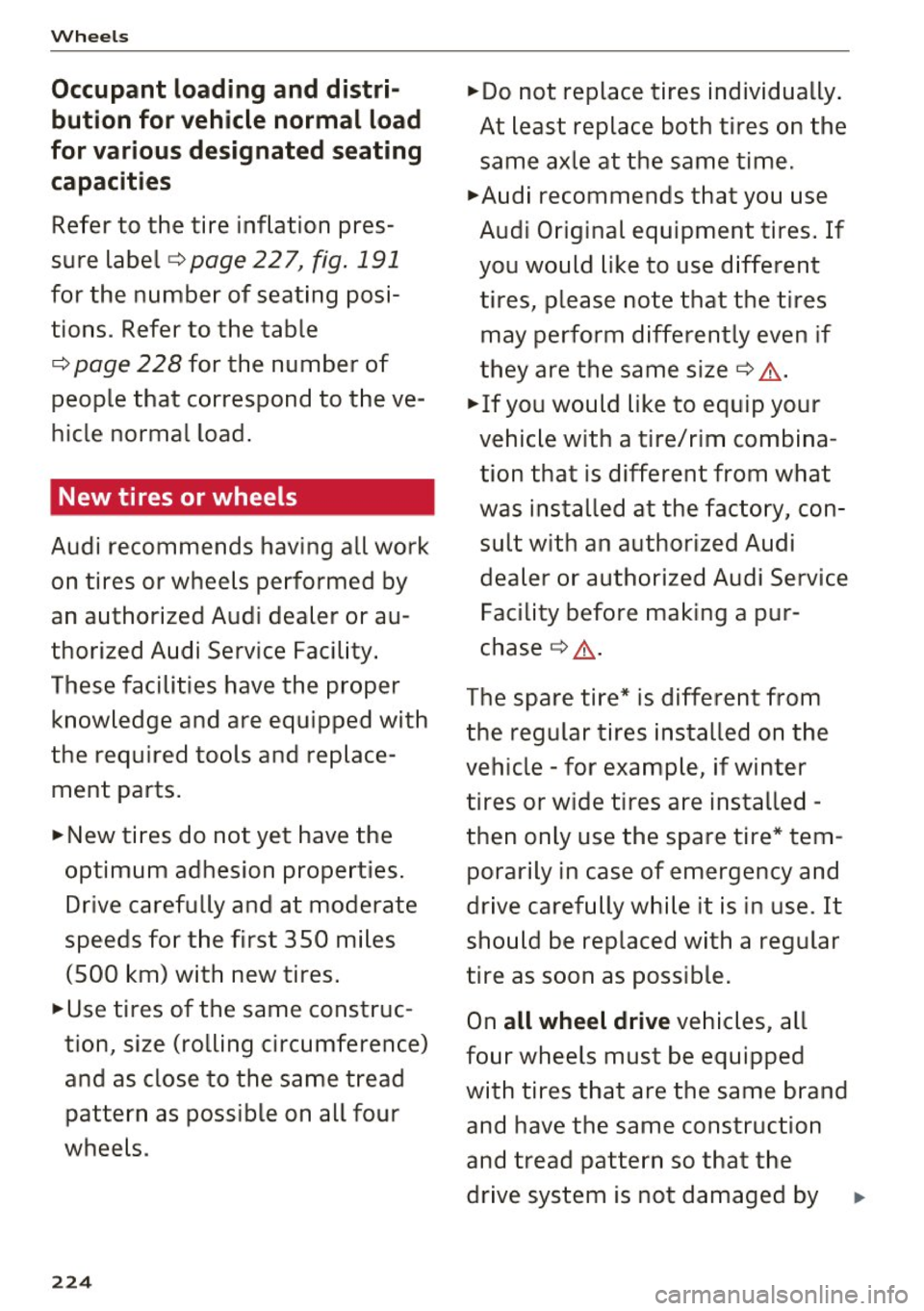
Wheels
Occupant loading and distribution for vehicle normal load
for various designated seating
capacities
Refer to the tire inflation pres
sure label ¢
page 22 7, fig. 191
for the number of seating posi
tions . Refer to the table
¢
page 228 for the number of
people that correspond to the ve
hicle normal load.
New tires or wheels
Audi recommends having all work
on tires or wheels performed by
an authorized Audi dealer or au
thorized Audi Service Facility.
These facilities have the proper knowledge and are equipped with
the required tools and replace
ment parts.
.,.New tires do not yet have the
optimum adhesion properties. Drive carefully and at moderate
speeds for the first 350 miles (500 km) with new tires .
.,.Use tires of the same construc
tion, size (rolling circumference)
and as close to the same tread
pattern as possible on all four
wheels .
224
.,.Do not replace tires individually.
At least replace both tires on the
same axle at the same time.
.,.Audi recommends that you use
Audi Original equipment tires. If
you would like to use different
tires, please note that the tires may perform differently even if
they are the same size ¢
,&.
.,. If you would like to equip your
vehicle with a tire/rim combina
tion that is different from what
was installed at the factory, con
sult with an authorized Audi dealer or authorized Audi Service
Facility before making a pur
chase ¢&, .
The spare tire* is different from
the regular tires installed on the
vehicle -for example, if winter
tires or wide tires are installed -
then only use the spare tire* tem
porarily in case of emergency and
drive carefully while it is in use. It
should be replaced with a regular
tire as soon as possible.
On
all wheel drive vehicles, all
four wheels must be equipped
with tires that are the same brand and have the same construction
and tread pattern so that the
drive system is not damaged by .,.
Page 227 of 278

different tire speeds. For this reason, in case of emergency, only
use a spare tire* that is the same
circumference as the regular
tires.
&_ WARNING -
-Only use tire/rim combina tions and suitable wheel bolts
that have been approved by
Audi. Otherwise, damage to
the vehicle and an accident could result.
-For technical reasons, it is not possible to use tires from oth
er vehicles - in some cases,
you cannot even use tires from
the same vehicle model.
-Make sure that the tires you
select have enough clearance
to the vehicle . Replacement
tires should not be chosen
simply based on the nominal
size, because tires with a dif
ferent construction can differ
greatly even if they are the
same size. If there is not
enough clearance, the tires or
the vehicle can be damaged and this can reduce driving
safety and increase the risk of
an accident.
Wheels
-Only use tires that are more
than 6 years old when abso lutely necessary and drive
carefully when doing so.
-If you install wheel covers on
the vehicle, make sure they al
low enough air circulation to
cool the brake system. If they
do not, this could increase the
risk of an accident.
Tire wear/damage
Fig. 189 Tire profile : treadwear indica
tor
Tire wear
Check the tires regularly for wear .
-Inflation pressure that is too low
or high can increase tire wear
considerably.
-Driving quickly through curves, rapid acceleration and heavy
braking increase tire wear .
-Have an authorized Audi dealer
or authorized Audi Service Facili
ty check the wheel alignment if
there is unusual wear. ..
225
Page 230 of 278

Wheels
the risk of an accident. Read and follow the important safe
ty precautions in ¢ page 229,
Tires and vehicle load limits.
-The tire must flex more if the
tire pressure is too low or if
the vehicle speed or load are
too high. This heats the tire up
too much. This increases the
risk of an accident because it
can cause the tire to burst and
result in loss of vehicle con
trol.
-Incorrect tire pressure in
creases tire wear and has a
negative effect on driving and
Tire pressure table
Please note that the informat ion
contained in the following table
was correct at the time of print
ing, and the information is sub
ject to change. If there are differ
ences between this information
and the tire pressures specified
on the label on the driver's side 8- pillar, always follow the specifica
tion on the 8-pillar label
¢ page 227, fig.190.
228
braking behavior, which in
creases the risk of an accident.
(D Note
Replace lost valve caps to re
duce the risk of damage to the
tire valves.
@ For the sake of the environment
Tire pressure that is too low in
creases fuel consumption.
(D Tips
Audi recommends using the
tire pressure specified for a normal load
¢ page 228 or for
a full load when the vehicle is
partially loaded .
Make sure that the tire designa
tion on your tire matches the des ignation on the tire pressure label
and the tire pressure table.
The following table lists recom
mended tire pressures in cold
tires according to the load and the size of the tires installed.
Page 235 of 278

..... N
0 ::..:: co .....
You can also use all season tires instead of
winter t ires . Please note that in some coun
tries where w inter t ires are required, only
w inter t ires with the
& symbol may be per
m itted.
Snow chains
Snow chains improve trac tion in the snow.
"' Only install snow chains on the front wheels.
This applies also to ve hicles w ith all wheel
drive* .
"' Check and correct the seating of the snow
chains if necessary after driving a few feet . Fol
low the instructions from the manufacturer.
"' Note the max imum permitted speed when d riv
ing with snow chains . Do not ex ceed 30 mp h
(50 km/h).
Snow chains not only imp rove the
driving in win
ter road cond itions, but also the
braking .
Use of snow chains is only perm itted with certain
r im/t ire combinations due to tec hnical reasons .
Check w ith an authorized Aud i dealer o r autho r
iz ed A udi Service Fac ility to see if yo u may use
snow cha ins.
Use
fine-mesh snow chains . They must not add
mo re than 0.53 inch (13 .5 mm) in height , includ
in g the chain lock.
You must remove the chains when driving on roads that are
free of snow. When roads are free
of snow, snow chains can impair handling and
damage the t ires, and t he cha ins w ill quickly be
destroyed.
_& WARNING
Us ing in co rrect snow chains o r inst alling snow
chains incorrectly can result in loss o f vehicle
cont rol, which inc reases t he risk of an acci
dent.
([) Note
Snow chains can damage the rims/whee l cov
ers * if the chains come into direct con ta ct
Wh eel s
with them. Remove the whee l covers* fi rst .
Use coated snow chains .
(D Tips
When driv ing wi th snow chains, it may he lp to
switch on sport/offroad mode<=>
page 178.
Low aspect ratio tires
Your Audi is factory -equ ipped with low aspect ra
tio t ires . These tires have been thorough ly tested
and been selected spec ifically for your model for
their superb performance, road fee l and handling
under a var iety of dr iv ing condit ions . Ask your au
thorized Aud i dea le r fo r more detai ls .
The low aspect rat io of these tires is indica ted by
a numeral of
55 or less in the t ire 's size des igna
tion . The numeral represents the ratio of the
t ir e's s idewa ll height in relation to its t read width
exp ressed in perce ntage. Conve ntiona l tires have
a height/wid th ra tio of 60 or more.
The performance of low-asp ect-ratio tir es is par
ticularly sen sitive to improper inflation pres
sure. It is therefore important that low aspect ratio tire s are inflated to the specified pressure
and that the inflation pressure i s regularly
checked and maintained. Tire pressures should
be checked at lea st once a month and alway s
before a long trip
¢ page 22 7 .
What you can do to avoid tire and rim
damage
Low aspect ratio tires can be damaged more easi
l y by impact with potho les, curbs, gullies or
ridges on the road, particularly if the tire is un
der i nflated.
In order to minimize the occurrence of impact
damag e to the tires of yo ur v ehicle, we recom
mend that you observe the following preca u
tions:
- Always maintain recommended inflation pres
sures . Check yo ur tire pressure every 2,000
m iles (3,000 km) and add air if necessary.
- Dr iv e carefully on roads w ith potholes, deep
gullies or ridges. The impact from dr iving
through or over such obstacles can damage
233